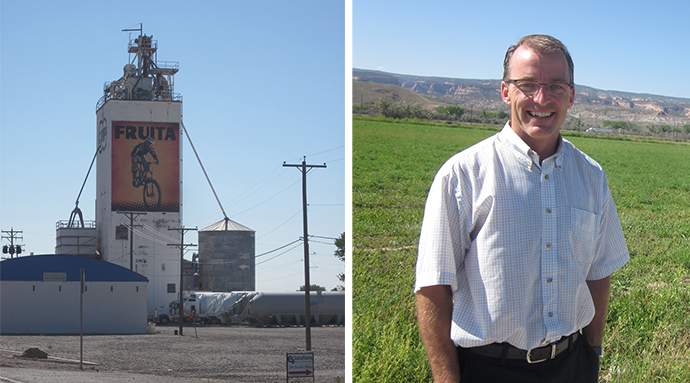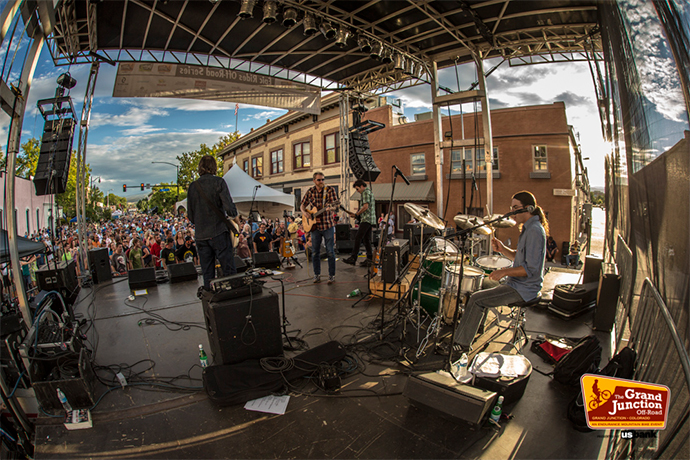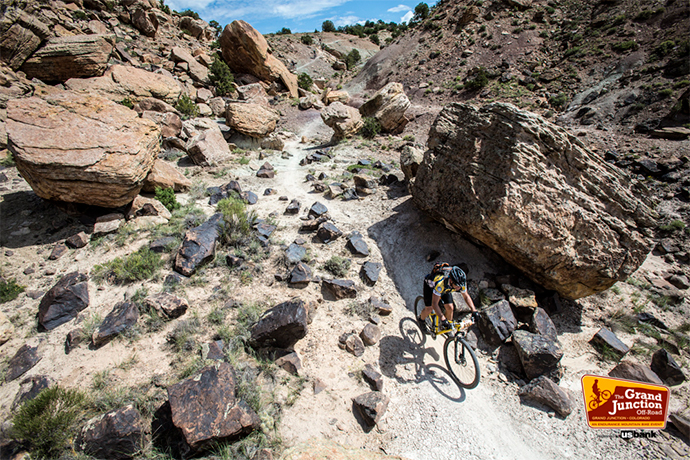What if a company came to town, did its business, provided you with a walking, talking digital postcard for your quality of life, then packed up and left, leaving your community a bit richer than before in both cash flow and reputation?
And what if they aimed to do that every year?

That’s what participant-driven sporting events do all the time around the country. And it’s what Epic Rides, a Tucson-based off-road mountain bike event company, just pulled off in Grand Junction, Colo., over Labor Day weekend, at the Grand Junction Off-Road, three days of racing for pros and amateurs punctuated by concerts and other festivities in a newly refurbished downtown on Colorado’s Western Slope.
But Epic didn’t do it alone.
“It really does require everybody wanting to see it happen,” said Todd Sadow, president of Epic Rides, in an interview on Labor Day morning in the hotel lobby, as riders, their families and sponsors delivered a stream of positive feedback over their yogurt, fruit, waffles and coffee. Sadow gave credit to the city, Mesa County, the federal Bureau of Land Management (more than two-thirds of the area is public lands) for getting past obstacles and red tape in the year-long run-up to the event, and aligning themselves behind its promotion. But it’s as much about hard assets as it is about cheerleading.
“Downtown is really cool, and it’s very high-functioning,” said Sadow, even though some longstanding merchants are still getting the hang of extending their hours. Among other benefits, he said, Main Street was refurbished with piped-in power, water and audio infrastructure for events just like Epic’s. “That’s a forward-thinking downtown,” he said. “Those are Grade-A amenities.” When an event’s sponsors and organizers arrive and find wires waiting for them to plug in, he said, “That’s a big deal.”
Sadow, who launched Epic full-time in 2001 after managing shopping centers for General Growth Properties, worked closely with the Grand Junction Economic Partnership (GJEP), which represents the entire region.
“We haven’t done something like this before,” admitted Kelly Flenniken, GJEP’s executive director, the Friday morning before the big weekend got under way. But events like Epic’s fit like a knobby tire into the healthy lifestyle groove that’s always been a Colorado calling card — think organic food and yoga, top-flight healthcare and life sciences assets, craft brews and hand-crafted pizza, and outdoor recreation venues and the high-end gear companies that come with them. Grand Junction, say the locals, is one of those places where it’s a badge of honor to drive a $2,000 car with a $4,000 bike on top.
“What we’re trying to tell people is, ‘Come back and live and work in the place where you want to play anyway,” said Flenniken. “An event like this gets people more involved.” And the more people the better. That’s why GJEP and Epic worked to incorporate into the weekend a Friday night “Clunker Criterium” around downtown, children’s races and a headliner concert Saturday night featuring the band Cracker.
‘Authentic’ Gains Traction
Oh yeah, there were also the 15-mile, 30-mile and 40-mile races for pros and amateurs, with hundreds of riders hailing from such faraway places as Hawaii, Atlanta, Michigan, British Columbia, Japan, Alaska, Ontario and, well, Durango (which the male pro winner and runner-up call home). A $20,000 purse was part of the attraction, with equal checks for the men’s and women’s divisions, something that even in the progressive atmosphere of outdoor sports is still a rarity.
It was an event five years in the making, said Sadow, whose firm until now has staged the Whiskey Off-Road in Prescott, Ariz., every April for many years, as well as the 24 Hours in the Old Pueblo event in Tucson and the Tour of the White Mountains, also in Arizona. Grand Junction was the first step in what Sadow sees as a national expansion, with flagship events in every region of the country.

There’s every indication that Epic has, in mountain biking lingo, “dialed in the tread of the trail” for the future. Sadow is looking next to the Pacific Northwest (Boise, anyone?), as well as the Mid-Atlantic and South, where as a kid he first discovered mountain biking on the trails near Greenville, S.C.
Sadow’s No. 1 site selection criteria? The trails, of course.
“They have a great, world-class trail system,” said Sadow of Grand Junction’s network of pathways, including one nicknamed the Lunch Loops because that’s what a certain cohort of Western Slopers like to do on their lunch hour. “It was unknown for a long time,” he said. “Grand Junction has always been in the shadow of Fruita [next door to Grand Junction] or Moab [Utah].” But if you talk to enough people, he says, you’ll find that Moab was modeled after Grand Junction.
Flenniken said the event not only engaged the area’s three main biking clubs (one female, two male), but gave them an opportunity to assert bragging rights in a town where the “average Joe” sets the bar pretty high when it comes to fitness and gusto.
Clint Kinney, the city manager in Fruita, gets it. He’s watched his city grow from 6,000 to 13,000 residents over the past 11 years, as both retirees and the un-retiring types move in amid a downtown scene that includes a growing cadre of establishments such as the renowned Hot Tomato Café, a pizza joint in the best sense of the word run by world-class mountain biker Jen Zeuner and co-owner, photographer and fellow mountain biker Anne Keller. (Their investment in the restaurant, in fact, was helped by financing secured by U.S. Bank, the primary sponsor of the Epic Rides weekend.)
Fruita’s first go-round in tourism was based on dinosaur bones. But there’s nothing prehistoric about the vibe in town now, where new paths are being built to connect neighborhoods, downtown and, perhaps eventually, some 1,800 acres of industrial land still looking for takers with a penchant for redevelopment and for spectacular views of the Colorado Monument across I-70.
If you’re just starting to mountain bike, says Kinney, you go to Moab, just a 90-minute drive west. But “Fruita is where all the cool kids go.” He gets on the bike a couple times a week himself, and just recently battled the mind-over-matter challenges of a track known as Mary’s Loop, where the penalty for a miscalculation is only falling 300 feet into a river.
“My house is five minutes from some of the best hiking you can possibly imagine, and eight minutes from world-class mountain biking,” says Kinney, who moved to Fruita from Durango. “We have four bars, two brew pubs, Thai and sushi. It’s a small-town atmosphere, not a strip-mall suburban lifestyle. Downtown, people are in their bike shorts, eating their eggs, white collar and blue collar — it’s authentic.”
Measurable Impact
Grand Junction has the same vibe on a larger scale. Just check out the table turnover at Pablo’s Pizza, the activity at several bike shops or the title selection at the exquisitely curated Grand Valley Books, opened by wife-and-husband owners Margie Wilson and Frank Cooley in 2010 after their successful turnaround of another shop nearby. Both stores are in the black, an against-the-odds accomplishment, says Wilson, in a predatory bookselling marketplace.
“The work force in Grand Junction must be cherry-picked to get great employees, and we have the best retail employees imaginable,” she says. “They are terribly over-qualified, hard working, well educated and motivated employees who have made our jobs as small business owners quite wonderful.”

Clint Kinney, city manager for the City of Fruita (Grand Junction’s neighboring community) says “Fruita is where all the cool kids go” when it comes to mountain biking. Behind him is some of the 1,800 acres with a view of the Colorado National Monument where he and city leaders aim to attract some cool companies interested in redevelopment.
From the looks of things, bringing in a bike race series brought those small business owners some not-so-small business receipts. That’s the idea. But what’s the measurable economic impact of such an event?
Dr. Anthony Evans, senior researcher with the L. William Seidman Research Institute at Arizona State University’s W. P. Carey School of Business, has some answers. He led a study of Epic Rides’ Whiskey Off-Road event.
“A couple of things really stood out at the Whiskey Off-Road,” says Evans, whose institute has studied economic impacts of all manner of industries, institutions and events. “First, the incredible geographic spread of the participants and visitors. Over 90 percent of the people surveyed originated outside the Tri-City area, which perhaps is a tribute to the organization and quality of the event.
“The other thing that stood out was the major boost Epic Rides clearly gives to the local economy,” he continues. “We estimated that the 3-day event alone added over $4.4 million to the Tri-City local economy, including the creation of 96 jobs, and the generation of over $2.5 million in labor income. That’s ignoring any riders’ pre-run trips, or future visits to the area for non-event reasons. The hoteliers, bars and restaurants, and retailers we talked to were all delighted by the extra footfall it brought to Prescott.”
With such success, it’s no wonder that Destination Marketing Association International (DMAI) in October will release a new sports module of its popular Event Impact Calculator, presenting it as “the credible, sustainable, and consistent industry standard for determining the impact of sports events” because of its use of local data, among other factors. It will report on direct spending on local goods and services, and will calculate indirect and induced spending outputs in terms of jobs, wages, and tax contributions. The Sports Module includes Longwoods International survey results for 5,000 participants and attendees at sporting events, and primary studies on over 150 sporting events analyzed by Tourism Economics, a division of Oxford Economics relied upon by more than 100 tourism councils nationwide.
“Destination marketing organizations [DMOs] and destinations throughout our country are constantly looking at ways people are engaging,” explains Christine Shimasaki, managing director of DMAI’s empowerMINT.com and a former executive at the San Diego Convention & Visitors Bureau, “and active engagement seems to be a tremendous trend,” whether it’s sports, a festival or both. “I know that our destinations have been looking pretty hard at sports, and at their own organizations in terms of how they attract these sporting events.” She hazards a guess that around 80 percent of member DMOs have invested in personnel “to help them understand the marketplace and bring in those events.”
Over the years, ASU’S Seidman Institute has produced a variety of sport-themed economic impact studies for clients such as the PGA’s Waste Management Open, college football’s Fiesta Bowl, Turf Paradise and even Super Bowl XXX. Asked to compare spectator-driven events to participant-driven events, Evans says, “We haven’t actually compared two events, but a good experience at an event will often encourage a spectator to return for a non-sporting reason. For example, almost half of all riders and event visitors we surveyed at the 2013 Whiskey Off-Road said they would consider returning to the Tri-City area over the next 12 months for non-Whiskey reasons, thanks to their great experience at the event.”
Could there be an additional link between the hosting of a participant sporting event and general work-force health?
“You can always anecdotally link increased participation in a sport with the hosting of an event,” says Evans. “Every Olympics host city always talks about leaving behind some sort of legacy. But the key thing is the depth or intensity of that interest. Is it a short-term passing fad, or something that runs deeper?”

Evans says a recent study in the British Medical Journal suggested there’s insufficient evidence to confirm or deny a link between the health of a population and the hosting of major sport events. That said, however, “It’s hardly going to be a hindrance, though, is it?” he asks. “Around 150 kids participated in the Whiskey-Off Road — that was certainly a joy to watch.”
What about healthy incomes? Evans is loath to make the leap that the average income of triathloners or mountain bikers might mean participants are more likely to have influence in their employers’ facility location decisions:
“I suppose it’s possible,” he says, “although the nature of the business, its core target market, and the availability of an appropriate supply chain will obviously take priority. The primary legacy of hosting events like the Whiskey Off-Road is the short-term boost for the local economy, supplemented by more longer-term tourism or perhaps even second (vacation) home benefits.”
Ready to Roll
Some numbers from the Whiskey Off-Road survey:
- The average rider party size typically consists of 4 people.
- Around a quarter of all riders and event visitors from outside the area report household incomes of $100,000-$149,999. In addition, there are more rider households in percentage terms earning $150,000 or more per year, compared to event visitors. Over three quarters of all riders and visitors report household income higher than the national average of $52,762.
- Consistent with the higher household incomes, the reported educational attainment of riders is also significantly higher than the national average. “It seems reasonable to conclude, therefore, that mountain bike events have great appeal for affluent, well-educated people.”
- The average expenditure per rider or visitor party visiting from outside the community is $975, with lodging receiving approximately one-third of that expenditure, and more than three-quarters of rider parties staying for two to three nights. Bars and restaurants benefit from a quarter of the incremental revenue associated with the Off-Road event. Travel to and from the event accounts for over 20 percent.
- Thirty percent of the riders at the 2013 Whiskey off-Road had visited another part of Arizona immediately prior to their participation at the event, and 23 percent planned to visit another part of Arizona immediately after the weekend event. Almost half of all riders and event visitors at the 2013 Whiskey Off-Road also anticipated a return to the Tri-City area over the next 12 months for non-Whiskey Off-Road reasons, thanks to their great experience at the mountain bike event.”
It appears that experience was well replicated on Colorado’s Western Slope, meaning Sadow’s goal of national expansion is near.
“We’ve been building towards this expansion for five years,” he said, noting the “legitimate traction” the series had gained over the weekend in Grand Junction. “There’s been a big void for a national event marketing platform for mountain biking. There are other people trying to do it. But if my hunch is correct, we’ll be the only ones doing it correctly. I’ve been doing this for 15 years, and seen four try, but none have them have gotten traction past the events themselves. Based on what we experienced this weekend, in the next couple years we’ll be a pretty strong national series.”
Sadow is in talks with a couple cities in the Pacific Northwest, and is ready to hear from others in the South and Mid-Atlantic.
“Most people are pretty receptive,” he says. “The chance to highlight their natural resources is a neat opportunity. It’s a great offering for the community. It’s something that’s a healthy outlet, it’s forward thinking, and the demographic is strong.”
In fact, the strongest votes for growth in Grand Junction and beyond came from the demographic that matters most out on the trail: the riders in the saddle.
“The feedback from everybody who rode,” said Sadow, “is that everyone will bring a friend next year.”

